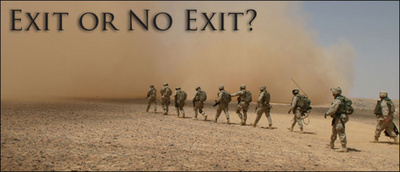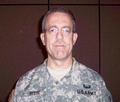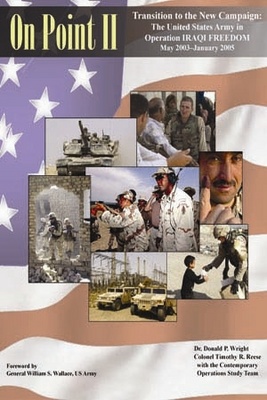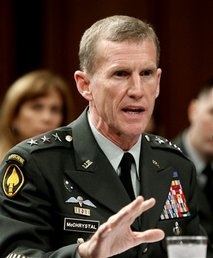 This is a follow-up on Tom Barnes’ VT post U.S. Advisor to Iraq Armed Forces: We need to leave soon. – A.P.
This is a follow-up on Tom Barnes’ VT post U.S. Advisor to Iraq Armed Forces: We need to leave soon. – A.P.
Yesterday there were two news stories that ran almost simultaneously, just a few hours after AP reported that a senior Army officer responsible for training of Iraqi troops as a top military advisor called for a expedited exit from Iraq, AP also reported shortly after that the Commanding General of our forces in Afghanistan has called for more troops.
First, we cover the call for an exit from Iraq, that Tom mentioned and then talk about more troops for Afghanistan.
Robert L. Hanafin
Major, U.S. Air Force-Retired
Veterans Advocacy Editor
VT News Network &
Our Troops News Ladder
A senior U.S. Army adviser (Colonel) to the Iraqi military command in Baghdad argues in an internal memo to his bosses that the U.S. should "declare victory and go home" next year, 16 months ahead of schedule.
 AP reporters Robert Burns and Lara Jakes report that Col. Timothy R. Reese wrote that the years-long American effort to train, equip and advise Iraqi security forces has reached a point of rapidly diminishing returns, and that Iraqi forces already are good enough to defend the government against the weakened terrorist and insurgent forces that remain.
AP reporters Robert Burns and Lara Jakes report that Col. Timothy R. Reese wrote that the years-long American effort to train, equip and advise Iraqi security forces has reached a point of rapidly diminishing returns, and that Iraqi forces already are good enough to defend the government against the weakened terrorist and insurgent forces that remain.
"The massive partnering efforts of U.S. combat forces with ISF (Iraqi security forces) isn’t yielding benefits commensurate with the effort and is now generating its own opposition," Reese wrote in a memo in early July to a number of U.S. military officials in Baghdad. He argued for ending the U.S. military mission in Iraq in August 2010 the date that President Barack Obama has said all combat troops will have withdrawn but a residual force of 35,000 to 50,000 troops will remain to continue training and advising the Iraqi security forces until a final pullout by December 2011. There are now 130,000 U.S. forces in Iraq.
Defense Secretary Robert Gates said after visiting Iraq that conditions have improved so much that it might be possible to accelerate slightly the withdrawal of combat forces this fall. But Gates did not mention the residual force of 35,000 to 50,000 troops to be left behind.
The Obama administration’s rationale for leaving a fairly large residual force beyond August 2010 rests on an expectation that the Iraqi government will require continued American military assistance even after the combat mission ends. U.S. commanders say security gains are fragile and reversible, and the Iraqi government needs years of assistance in developing a force capable of defending against external security threats. However, Colonel Reese notes that rationale is not economically feasible or necessary. The law of rapidly diminishing returns VT readers is an economic term and theory that basically means exactly what the Colonel said that, the return on American tax payer investment "isn’t yielding benefits commensurate with the effort and is now generating its own opposition."
This is normally an argument the American public hears from the Pro-Peace or anti-war movement, but coming from a senior advisor to the Iraqi Army is quite a different story.
As the Pro-Peace and anti-war activists, Veterans, and Military Families know all too well, there has been little public debate in the United States in recent months about the wisdom of leaving as many as 50,000 U.S. troops in Iraq after August 2010. Much of the focus has been on whether the pullout of U.S. combat forces over the coming year will leave a security void to be exploited by insurgent groups. In a study recently released by RAND concluded that the biggest risk to stability is that an Iraqi faction will abandon the peaceful political process that has developed over the past two years.
"U.S. withdrawal of combat units could make this more likely insofar as opposition groups see greater opportunity or need to resort to force," the study said.
The Reese memo was circulated this week to military officials, experts and journalists on an Internet distribution list. U.S. officers in Baghdad verified its authenticity.
 Reese previously served as director of the Combat Studies Institute at Fort Leavenworth, Kan. Last summer he co-authored an official Army history of the war from May 2003 to January 2005. Army study: Iraq occupation was understaffed which pretty much vindicated General Eric Shinseki’s warnings to the Bush administration that got him forced to retire.
Reese previously served as director of the Combat Studies Institute at Fort Leavenworth, Kan. Last summer he co-authored an official Army history of the war from May 2003 to January 2005. Army study: Iraq occupation was understaffed which pretty much vindicated General Eric Shinseki’s warnings to the Bush administration that got him forced to retire.
Reese wrote his memo shortly after U.S. combat forces moved out of Iraqi cities in accordance with a U.S.-Iraqi security agreement and shortly after Vice President Joe Biden visited Baghdad over the July 4 weekend. Reese mentioned the Biden visit as evidence supporting his argument that the U.S. has accomplished about all it can in Iraq.
"The vice president received a rather cool reception this past weekend and was publicly told that the internal affairs of Iraq are none of the U.S.’s business," Reese wrote. He cited a growing Iraqi chilliness to U.S. advisers (like himself) and commanders, unilateral Iraqi restrictions on U.S. forces and a declining Iraqi willingness to conduct combat operations with U.S. troops.
"As the old saying goes, ‘guests, like fish, begin to smell after three days,’" he began his memo. Since the signing of the U.S.-Iraqi security agreement late last year, "we are guests in Iraq, and after six years in Iraq, we now smell bad to the Iraqi nose."
[While Colonel Reese’s memo was making the rounds of top U.S. military leaders in Iraq, the Commanding General of our forces in Afghanistan is thinking about asking for more troops than the Obama administration or Congress may be willing to support or try selling to the American people. VT, Ed.]
US general may ask for more troops for Afghan war
By Associated Press Writers Anne Gearan And Lara Jakes
An extract: Gen. Stanley McChrystal, the U.S. general in charge of turning around the war in Afghanistan is likely to recommend significant changes to U.S. and NATO operations, military officials and others familiar with his forthcoming report said. Those changes could include additional U.S. troops despite political headwind against further expansion of the war.
 As Gen. McChrystal readies his assessment of the war, due next month, numerous U.S. officials and outsiders apprised of his thinking suggest McChrystal will request more American troops, probably including Marines, to be added next year. Pentagon officials and advisers spoke on condition of anonymity because the report is not complete, and because the number of forces to be requested is in flux. Several people familiar with the report cautioned that McChrystal could opt not to ask for an increase at all – recognizing that President Barack Obama and other White House advisers would not look favorably on adding new numbers to U.S. forces after already agreeing to boost their ranks by 21,000 troops earlier this year.
As Gen. McChrystal readies his assessment of the war, due next month, numerous U.S. officials and outsiders apprised of his thinking suggest McChrystal will request more American troops, probably including Marines, to be added next year. Pentagon officials and advisers spoke on condition of anonymity because the report is not complete, and because the number of forces to be requested is in flux. Several people familiar with the report cautioned that McChrystal could opt not to ask for an increase at all – recognizing that President Barack Obama and other White House advisers would not look favorably on adding new numbers to U.S. forces after already agreeing to boost their ranks by 21,000 troops earlier this year.
Military and defense officials have suggested that his report will identify shortfalls in the size and skills of Afghan forces and recommend additional U.S. trainers or others to help. A senior U.S. official said the rationale for needing more forces is tied to an altered strategy to clear and hold provinces where Taliban insurgents are fleeing as they are pushed out elsewhere.
McChrystal is also likely to recommend rearranging some U.S. and NATO forces to better meet a narrowed mission of protecting Afghan civilians and starve the insurgents of vital support. Top defense officials have conceded that combat operations against Taliban insurgents are stalemated.
Two of McChrystal’s civilian advisers, Anthony Cordesman of the Center for Strategic and International Studies and Stephen Biddle of the Council on Foreign Relations, said this week they expect some expansion of troops. Neither adviser would quantify those numbers. Biddle said Thursday he thinks the total number of troops in Afghanistan should number 300,000 to 600,000, including U.S., NATO and Afghan forces.

[Of note in 2002, Anthony Cordesman wrote a paper that would become instrumental in the discredited Iraq Weapons of Mass Destruction fantasy called Iraq and the Risk Posed by Weapons of Mass Destruction.

Stephan Biddle wrote about the pros and cons of trying to sell the American people on extending the war in Afghanistan called Is It Worth It? The Difficult Case for War in Afghanistan and his conclusion appear on balance. For every ultra right-wing NEOCON think tank there is VT readers a moderately conservative Democratic Party think tank. VT, Ed.]
Current forces include 62,000 U.S. troops and 39,000 allied troops, plus about 175,000 Afghan Army and police. Some of the allies plan to pull their troops home in the next couple of years.
[What Biddle is proposing is an increase of between a low of 24,000 and high of 324,000 additional troops most of them U.S. Army and Marines. VT, Ed.]
The Pentagon is now doing analysis to identify whether there are sufficient troops available or suited to the job. [This of course would depend on the availability of troops exiting Iraq. VT, Ed.] McChrystal is expected to discuss that review and his larger appraisal with Gates in the next two weeks.
Any request for additional U.S. forces would require touchy discussions with the White House and Congress. President Barack Obama approved a surprise addition of 4,000 U.S. trainers earlier in the spring, after his larger announcement of 17,000 combat troops, and administration and military officials had been signaling that further additions were unlikely for now.
Estimates of the additional forces McChrystal may request have ranged from a few thousand, or a brigade numbering 4,000 to 5,000 assigned to train the fledgling Afghan armed forces, up to 20,000 or more.
Obama’s additions will bring the U.S. presence to about 68,000 by the end of this year. That is roughly double the size of the U.S. force when Obama took office, and although Afghanistan is now considered the nation’s top military priority, the White House is deeply reluctant to keep adding, or to fight a skeptical Congress over the increase.
McChrystal was encouraged by superiors to assess the war bluntly and not to hold back in asking for troops, money, or equipment, and he knows he probably only has a short period to do so, defense officials and others in Washington and Afghanistan said.
To prepare the report, McChrystal gathered about a dozen military and outside civilian analysts six weeks ago and sent them on an intensive reporting trip through Afghanistan. The group finished work last week. One of the report’s authors said the group identified some basic organizational problems with the way the fight is divided among U.S., NATO and Afghan forces.
"One of the real challenges Gen. McChrystal is going to have is that up to this point the war is being fought as four separate fights: north, east, west and south," said Andrew Exum, a counterinsurgency specialist and blogger at the Center for a New American Security. "We are trying to think more holistically."
Speaking for himself, Exum said McChrystal faces a much wider challenge than coming up with enough troops and resources. The "operational culture" of the war has to change, he said, meaning a shift away from traditional military operation and procedures.
"Our efforts in this war will succeed or fail based upon relationships we’re able to build with our Afghan partners at every level," Exum said
"It’s very difficult to build those partnerships from behind an MRAP," he said, referring to the tank-like troop carriers that help protect U.S. soldiers from roadside bombs. "There’s going to have to be a real assumption of risk that U.S. and other allied forces might not feel comfortable with."
Posted by:
Robert L. Hanafin
Major, U.S. Air Force-Retired
GS-14, U.S. Civil Service-Retired
Readers are more than welcome to use the articles I’ve posted on Veterans Today, I’ve had to take a break from VT as Veterans Issues and Peace Activism Editor and staff writer due to personal medical reasons in our military family that take away too much time needed to properly express future stories or respond to readers in a timely manner.
My association with VT since its founding in 2004 has been a very rewarding experience for me.
Retired from both the Air Force and Civil Service. Went in the regular Army at 17 during Vietnam (1968), stayed in the Army Reserve to complete my eight year commitment in 1976. Served in Air Defense Artillery, and a Mechanized Infantry Division (4MID) at Fort Carson, Co. Used the GI Bill to go to college, worked full time at the VA, and non-scholarship Air Force 2-Year ROTC program for prior service military. Commissioned in the Air Force in 1977. Served as a Military Intelligence Officer from 1977 to 1994. Upon retirement I entered retail drugstore management training with Safeway Drugs Stores in California. Retail Sales Management was not my cup of tea, so I applied my former U.S. Civil Service status with the VA to get my foot in the door at the Justice Department, and later Department of the Navy retiring with disability from the Civil Service in 2000.
I’ve been with Veterans Today since the site originated. I’m now on the Editorial Board. I was also on the Editorial Board of Our Troops News Ladder another progressive leaning Veterans and Military Family news clearing house.
I remain married for over 45 years. I am both a Vietnam Era and Gulf War Veteran. I served on Okinawa and Fort Carson, Colorado during Vietnam and in the Office of the Air Force Inspector General at Norton AFB, CA during Desert Storm. I retired from the Air Force in 1994 having worked on the Air Staff and Defense Intelligence Agency at the Pentagon.
ATTENTION READERS
We See The World From All Sides and Want YOU To Be Fully InformedIn fact, intentional disinformation is a disgraceful scourge in media today. So to assuage any possible errant incorrect information posted herein, we strongly encourage you to seek corroboration from other non-VT sources before forming an educated opinion.
About VT - Policies & Disclosures - Comment Policy



